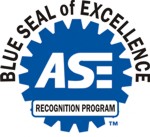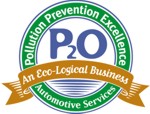 It’s “15-years-old-or-newer for NEW clients”, but there’s a little more to it than that.
It’s “15-years-old-or-newer for NEW clients”, but there’s a little more to it than that.
If you were driving by the shop recently you may have noticed a car that stood out from the ones we normally service. Nancy R. had her stunning, mint-condition, cherry red, convertible 1964 Pontiac LeMans in for its periodic Minor Interval Service. Even people who aren’t ‘old car buffs’ turn their heads at this one… it’s a GORGEOUS car and a tribute to a bygone automotive era. We weren’t its first mechanic, but Nancy has worked with us well over 20 years to keep her baby ‘safe, breakdown-free, and operating at its best’, and so far it’s working… her LeMans still drives like the day it was born.
But we disappoint potential new clients (and confuse existing ones) every day with our “15-years-old-or-newer policy”. If that’s our policy, then what is a 61-year-old car doing in our stalls? This seemed like another good opportunity to review our older vehicle policy.
What is our older vehicle policy?
The policy is simple: “We don’t accept NEW clients with vehicles more than 15 years old”. Note that it says “NEW” clients… FOR EXISTING CLIENTS, YOUR VEHICLE WON’T ‘AGE OUT’ ONCE WE START SERVICING IT!
Many people don’t like this at all, and it’s the biggest single source of our bad reviews. They think it’s suspicious to say ‘no’ to anyone who wants to spend money with us, or accuse us of just wanting to work on ‘the easy stuff’ to keep our ratings high, or think we’re just ‘car snobs’. Surprisingly, none of those are our reasons.
Why DO we have this policy?
Most shops look at people as a series of ‘customers’ buying a one-time service. There’s nothing necessarily wrong with that, but we’ve been in business almost 40 years because we center our service on successful long-term client relationships. We know we could make lots of money from working on older vehicles, but we also know it’s rarely in the clients’ interest to do it. We’ve found through hard experience that it’s almost impossible to build a solid service relationship around older, often challenged vehicles.
We have many longstanding clients with older vehicles, but we maintained their vehicles when they were newer and continued to service them as they aged. We’ve developed relationships with these clients. One of our biggest values is letting clients know when the economic viability of their vehicle has passed and it’s time to move on; not just fixing the current failure and getting back on the road. Once we’ve built a trusting service relationship with a client, they listen to us if there is a glitch in a repair or we tell them it’s time to part with their vehicle. It’s difficult to build that kind of relationship around a vehicle that is already worn out.
Our two major older-vehicle calls
The ‘older vehicle’ calls we get fall into two broad categories… neither are good.
The Limper- Someone driving an old, failing vehicle that they are just trying to patch together. They just want the check engine light off to pass DEQ and aren’t worried about the sketchy brakes, massive oil leaks, or glitchy transmissions. We deeply sympathize with people whose budgets won’t cover a safe and reliable vehicle (we’ve all been there!), but we think it’s exploitative to take their money when it would be better spent on a new vehicle.
The Lucky- Many, many times we get people with old vehicles (and even some newer ones) who tell us they’ve done all the oil changes and the vehicle hasn’t needed anything for years. Gosh, it’s just been a great car! But just because you haven’t DONE anything for your vehicle doesn’t mean it hasn’t NEEDED anything. Those fluid changes, shocks and struts, timing belts, and much, much more have been building up and if you haven’t addressed them for years then you’re due for years of catchup. If a new client brings their ’great car’ to us for the first time and then we give them a laundry list of thousands of dollars in maintenance and repair, do you think they would trust us on it? Should they? You see why this is a bad basis for longterm relationship.
But rules can be broken
The 15-years cutoff isn’t magic, it’s a guideline from years of experience. We know it covers most vehicles but there are outliers. Some manufacturers like Toyota or Honda can still hold up well at 15 years, and there are, of course, people like Nancy who actually DO stay on track for maintenance and repair. We CAN, and sometimes DO, make exceptions to our 15-year rule.
IF YOU WANT US TO CONSIDER SERVICING YOUR OLDER VEHICLE…
- We can only bend the rules so far. We might consider a 16- or 17-year old vehicle, but we won’t look at something 20 or 25 years old under any circumstances. Mileage matters too. A 16-year-old Toyota with 150,000 miles is much different than one with 300,000.
- We’ll do a ‘Challenge Inspection’ to see if the vehicle is worth supporting, both to you and us. This is the same Comprehensive Inspection we do for all incoming vehicles but normally we’re providing mechanical information to our client. For our Challenge Inspection we’re making decisions ourselves about whether we can service the vehicle in good conscience.
- We won’t charge you for the inspection unless the vehicle passes.
- If your vehicle passes inspection, great! We’ll take care of it as long as it makes sense for you. If not, we’ll refer you to another shop that handles older vehicles.
A word from Tom
Our repair and maintenance programs will extend a vehicle’s lifespan, but it’s rarely worth playing “catch up” to get an older, poorly maintained vehicle running safely and reliably. We hate to say “no” to any potential new client, but we have too much respect to start a relationship that is not mutually beneficial. Vehicles should come and go, but a service relationship can and should last for generations.
We’ve done our best to explain the details of our older-vehicle policy here, but Tom did a better job in just 60 seconds in one our old KPOJ radio spots. We’ll close with words from The Man himself…
“When I started in the auto service industry in the seventies, I was told ‘no vehicle is ever beyond repair’.
Those used up vehicles weren’t economically totaled rolling illusions; they were “roses”… which is true, from a repair shop’s viewpoint.
Poorly maintained vehicles tend to gobble the most money right before they die… it can be a waste trying to squeeze out those last few miles.
Our clients trust us to give solid advice that’s in their best long term interest. We’ll recommend against repairs when we know it’s the right advice to maintain loyal clients for years to come.
Vehicles should come and go, but client relationships should endure.”












